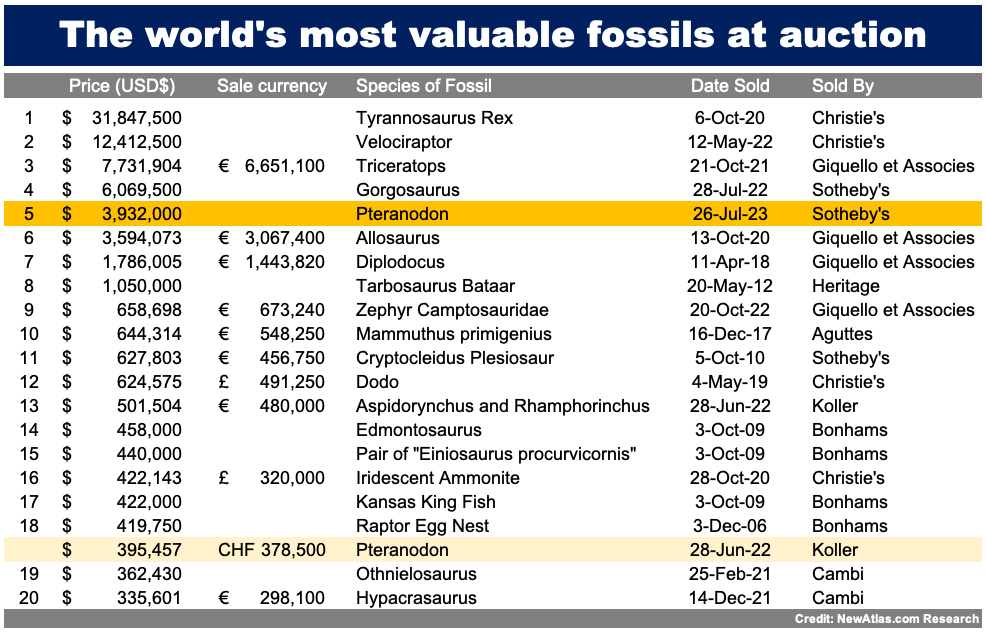A rare and large Pteranodon skeleton sold at a Sotheby’s auction in New York this evening for US$3,932,000, adding further weight to the influence of the Jurassic Park franchise and moving into the top five most valuable fossils of all-time: behind only Tyrannosaurus Rex, Velociraptor, Triceratops and Gorgosaurus.
Michael Crichton’s Jurassic Park franchise awakened the world to the real life monsters of Earth’s past and it has been anointing auction block superstars for a quarter century, with yet another joining the multi-million-dollar fossil club this evening.
Jurassic Park has been turning relatively unknown monsters into brand-name killers with auction block credibility ever since Sue the Tyrannosaurus Rex sold for $8.3 million in 1997, thanks to it becoming the cover-star of the 1990 best-selling novel Jurassic Park and the billion-dollar-box-office hit 1993 Steve Spielberg movie of the same name.

Indeed, Crichton and Spielberg kickstarted an entirely new auction genre with the dinosaur awareness their stories created, as prior to Sue, a fossil of any sort had never come close to reaching $1 million at auction and since then there have been 17 such sales, with the record price for a fossil now multiplied by two orders of magnitude since the Jurassic Park box office juggernaut first launched.

Tonight, we saw the largest Pteranodon skeleton ever to go to auction, and the supersized carnivorous flying reptile that has featured in every Jurassic Park franchise movie and video game since launch, did not disappoint. Bidding started at $2 million, and progressed rapidly in $200,000 increments to $3.2 million. The decisiveness of the winning bidder suggested that they had a big bankroll and equal amounts of determination. With the buyer’s premium added, the final price amounted to $3,932,000, making the Pteranodon one of the most valuable fossil finds of all time.

One of the many factors influencing the value of 85-million-year-old fossils is rarity – finding bones that haven’t turned to dust is hard enough, but the Pteranodon’s bones were designed for flight and were hence hollow and the walls were thin, so Pteranodons make for particularly fragile fossils that rarely last this long.
Partial Pteranodon skeletons found elsewhere have suggested that the frightening carnivorous reptile could grow much larger than double the size of the specimen that sold this evening. With a wing span of 20 feet (6 m), it was double the size of the last Pteranodon to sell at auction at Koller Auktion in Vienna last year, but less than half the size of some that have been found. That means that the larger specimens of the species would have had a larger wingspan than an F35 Joint Strike Fighter plane.
The Pteranodon really hit prime time in Jurassic Park III, and like the Velociraptor, the only thing wanting for the Pteranadon to become an auction block star was a suitably large fossilized skeleton. It took decades before a suitably complete and large velociraptor skeleton was found on private land and could hence go to auction, but when it did, it surpassed all the brand-name dinosaurs but Tyrannosaurus rex, fetching $12,412,500 at a Christie’s auction in 2022. Again, without a bit of Spielberg exaggeration and the Jurassic Park awareness, it would almost certainly have fetched far less.

Anyway, it’s Geek Week at Sotheby’s and history was made today with the sale of Horus, which now looks certain to be the first non-dinosaur to be admitted to the global pantheon of child-endorsed monsters, joining the list of usual suspects: Tyrannosaurus rex, Velociraptor, Triceratops and Diplodocus.
Source: Sotheby’s
Source of Article